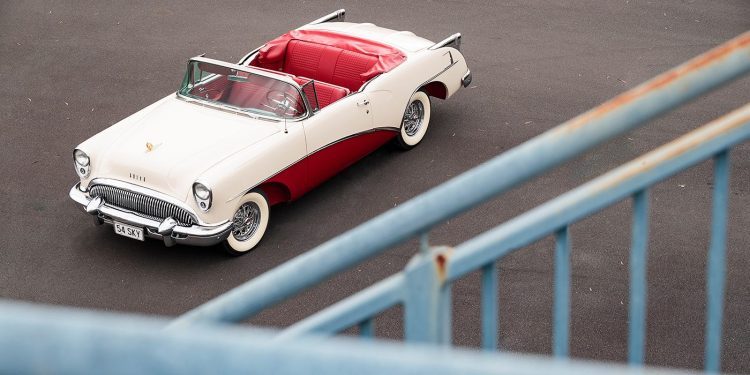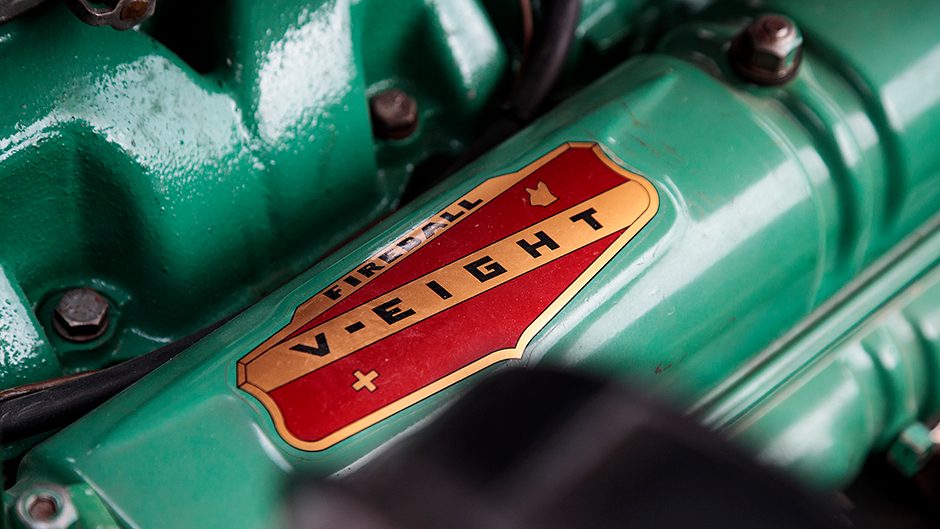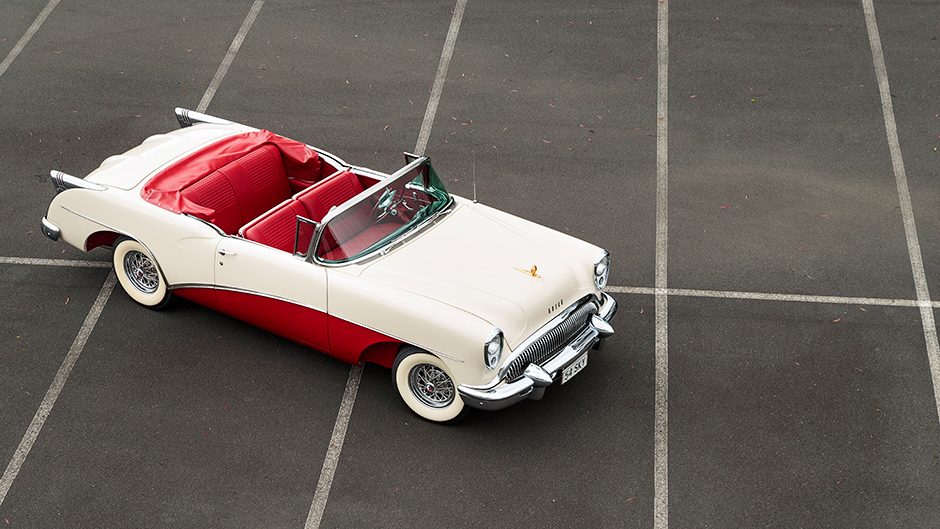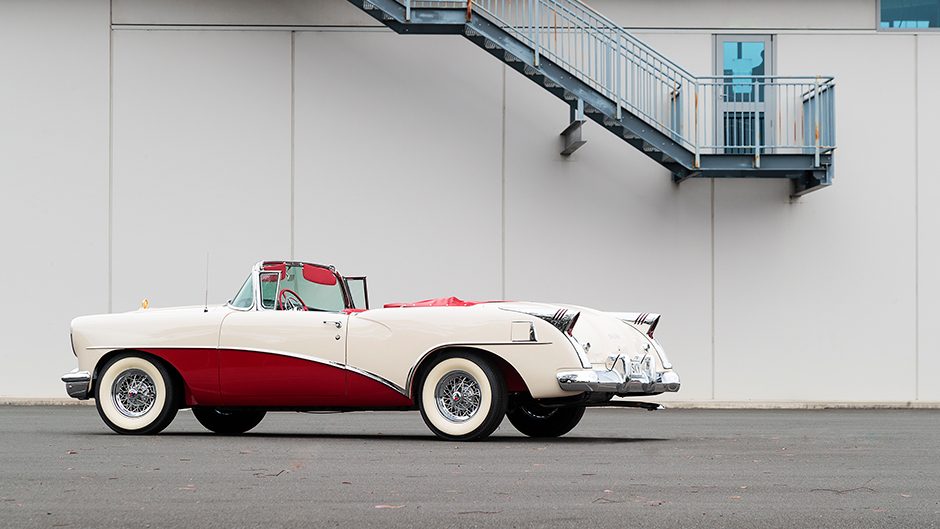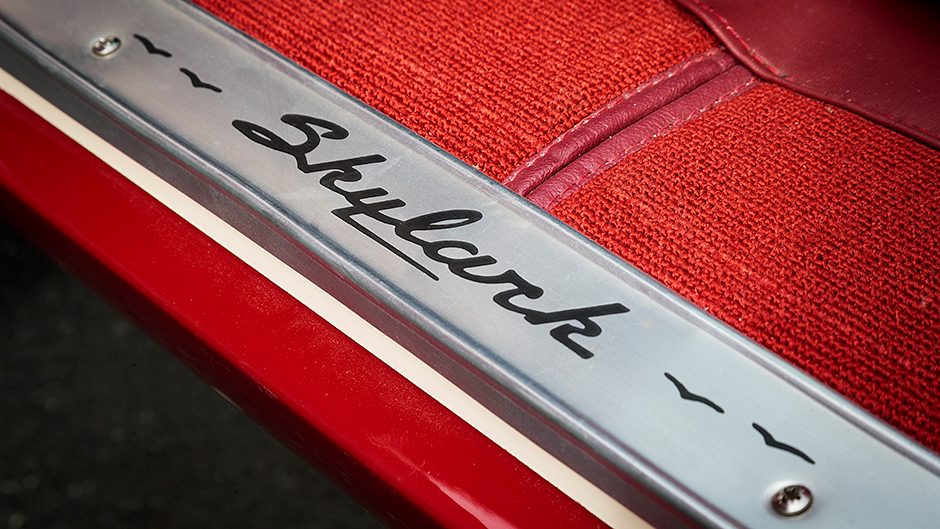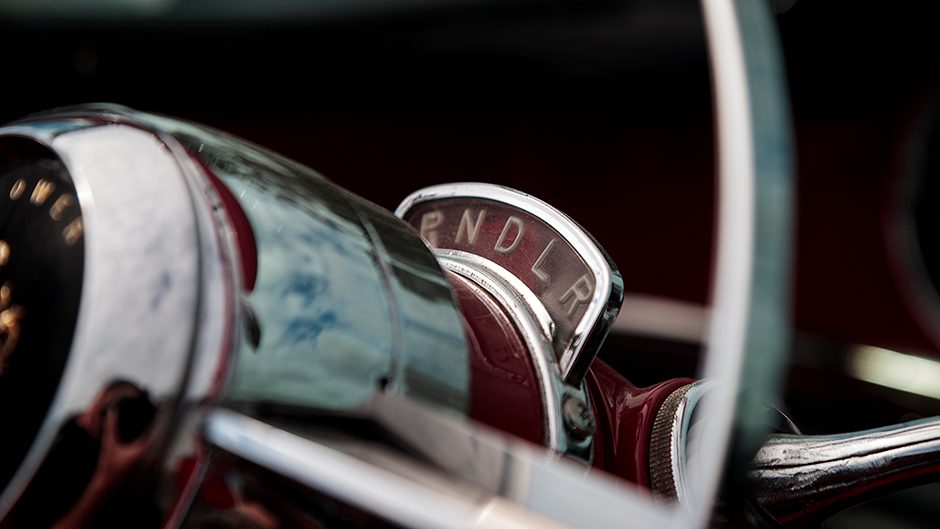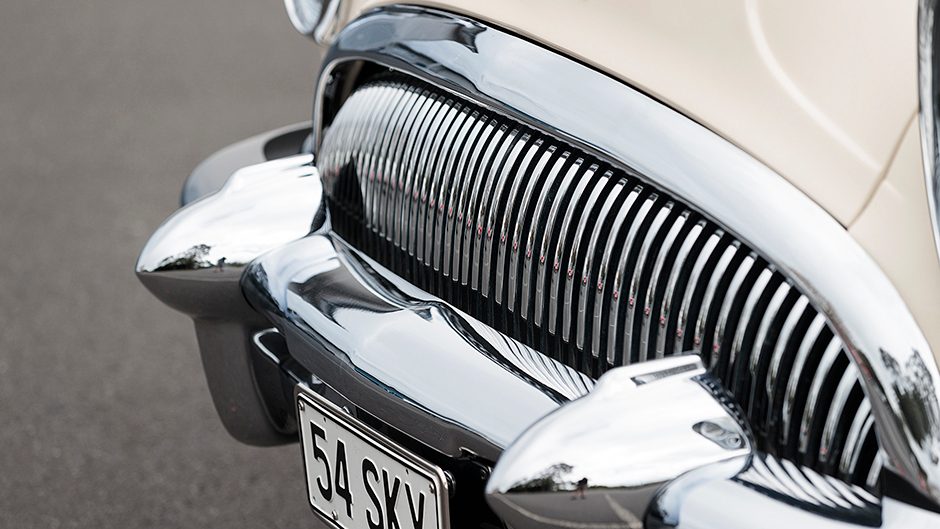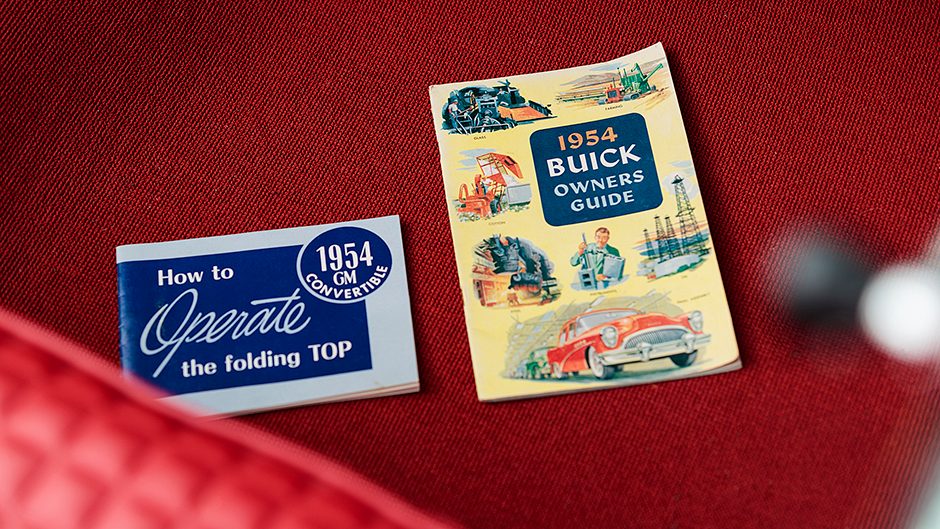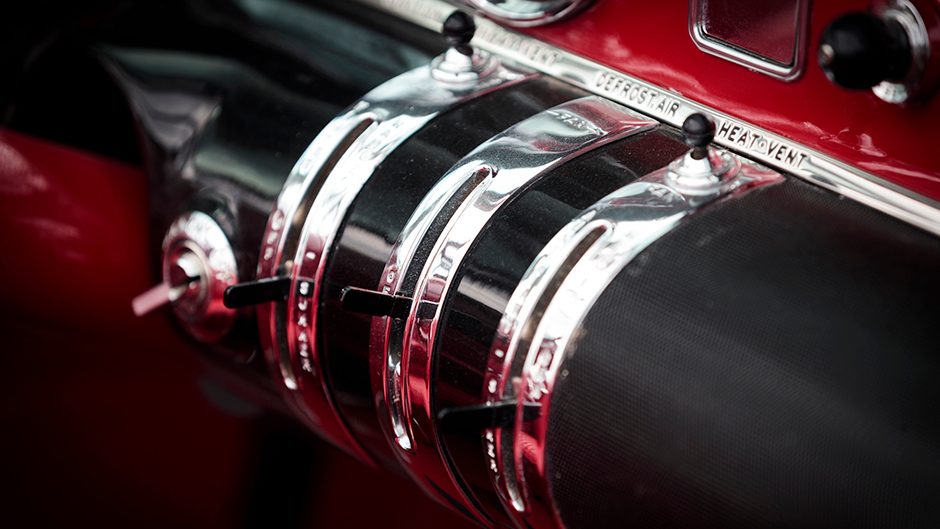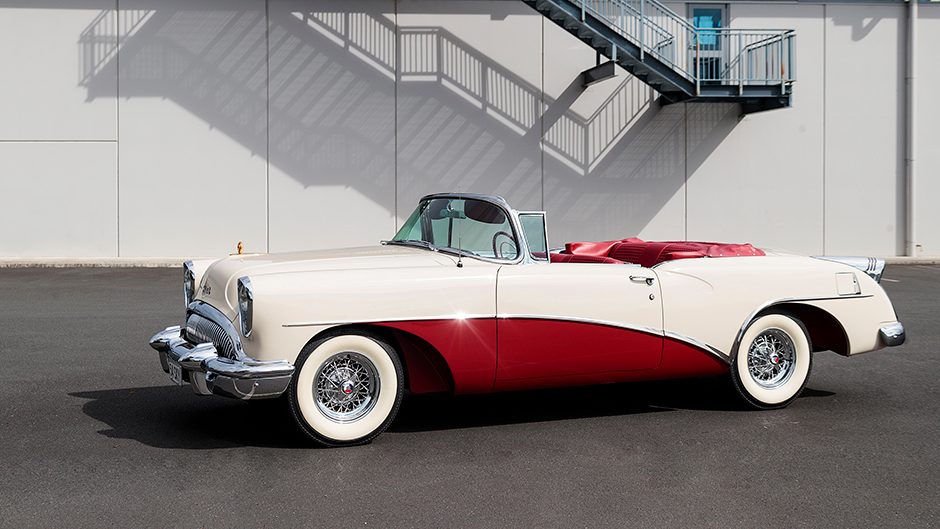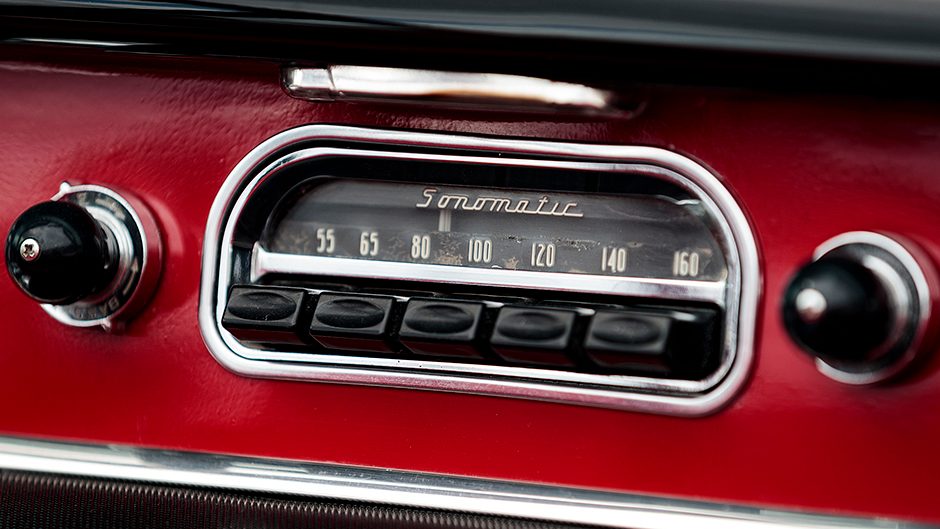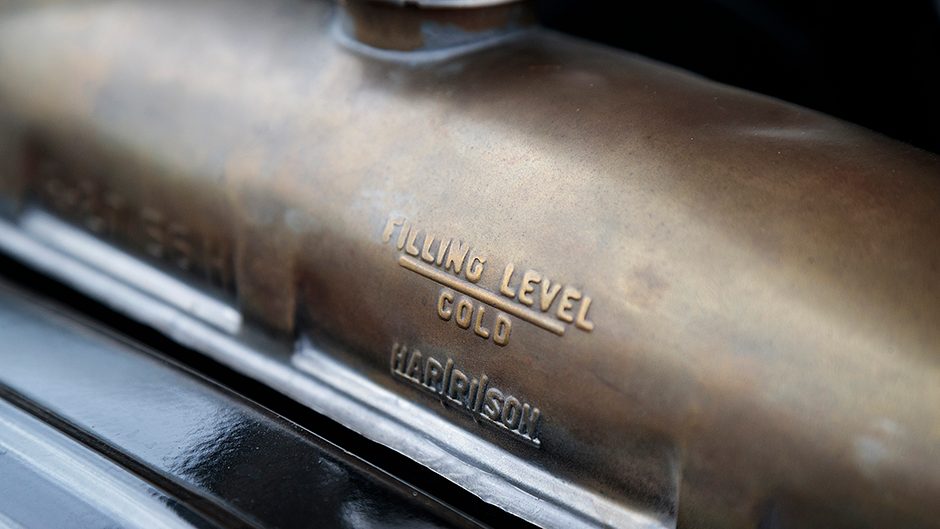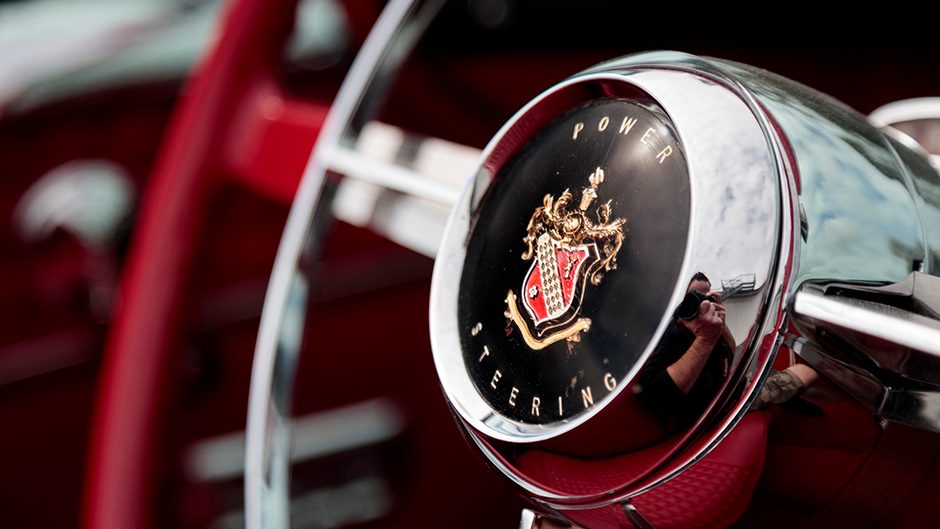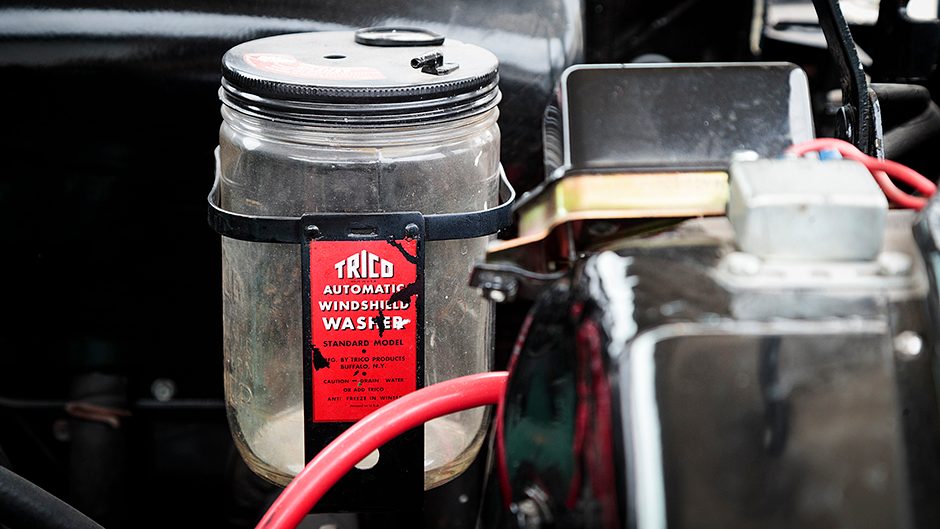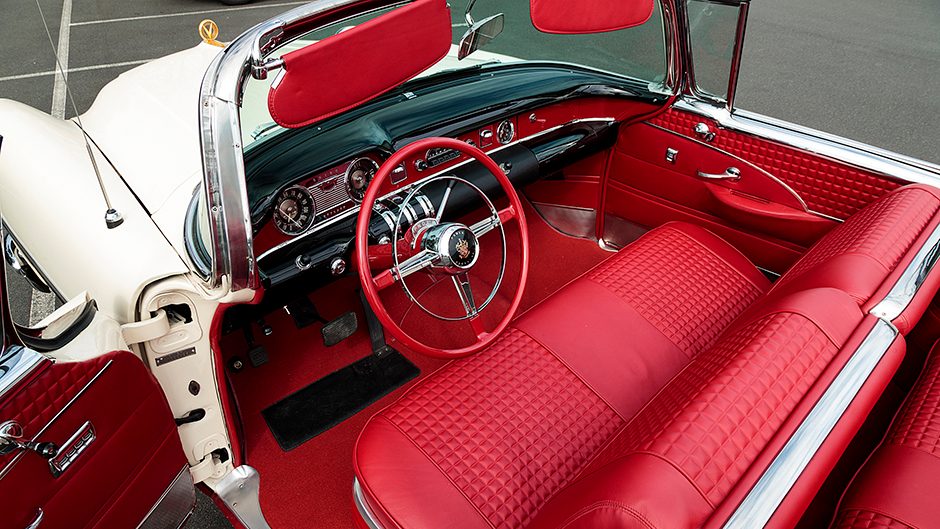1954 Buick Skylark
Words Paul Owen | Photos Tom Gasnier
Buick’s 1953 Skylark was an expensive 50th birthday present to itself. The following year, just 836 Skylarks were made, of which approximately 75 remain. You’ll find one of these ultra-rare 54s at the Classics Museum in Hamilton.
These are tough times for General Motors currently, as witnessed by 50,000 workers in the US on a prolonged strike, Holden going backwards, and the recent shutdown of the corporation’s Canadian manufacturing plants. The future for GM looked a lot rosier when this ultra-rare 1954 Buick Skylark was made sixty-five years ago.
Back then, the Buick division was sitting third in the US sales race, and could afford to give itself an indulgent birthday present to celebrate its Golden Anniversary. That present was the 1953 Buick Skylark, the slightly larger precursor to this ’54. Taking its name from a popular 1942 Hoagy Carmichael song, the first Skylark was a no-expense-spared celebration of the brand.
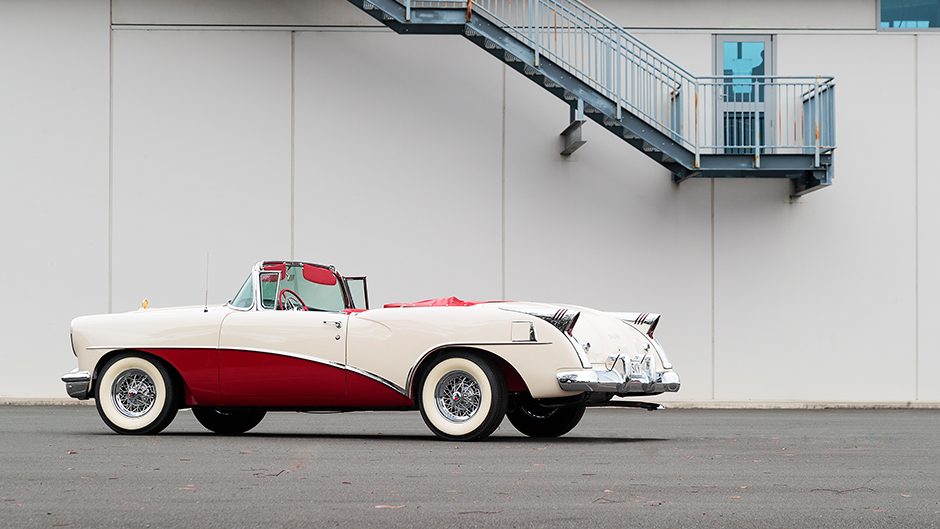
It was also a harbinger of a whole new direction in automotive style and marketing. For the Skylark was also one of the first limited-edition models launched by a mainstream American car maker. Its visual suggestion of increased sportiness and performance cut a design pathway that would be tracked by cars like the Plymouth Sport Fury and Ford Thunderbird.
Here was the first true American alternative to smaller European sports cars, albeit one built to fit the ‘bigger is better’ ethos that continues to dominate the automotive tastes of the world’s largest economy today. The original Skylark was also one of the first cars from Detroit whose design showed the influence of the Californian custom car scene.
According to some car historians, the Big Three had previously resisted making what some might refer to as a ‘kustom’ because the most influential hot rodders of the time were Hispanic Americans. During the 1940s, these Spanish-speaking ‘cartisans’ had developed a new style for their chopped and channeled sedans called the paduco, forerunner of the Low Rider. It was the paduco that would influence many cars from the Californian born-and-raised head of GM design, Harley Earl.
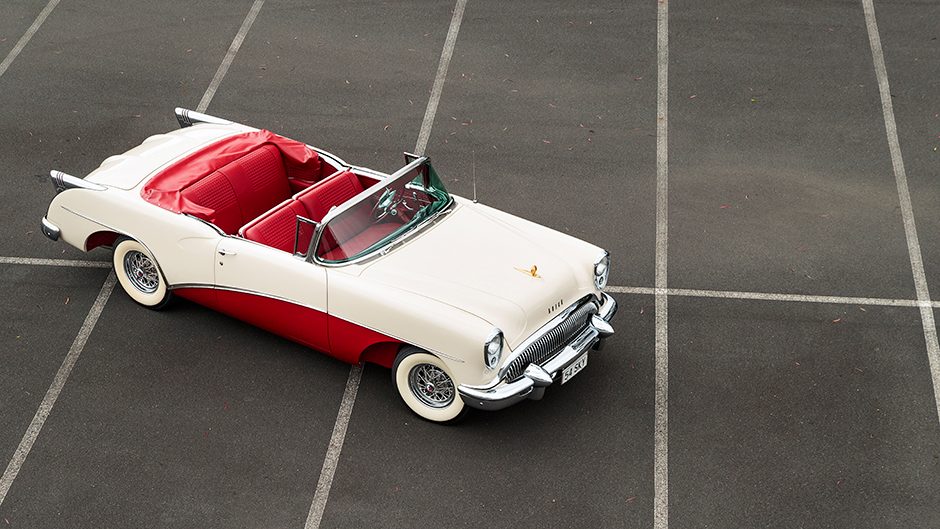
Earl wasn’t the only GM insider who had fallen under the spell of the paduco. Another was Ned Nickles, the Buick designer who, in 1951, had built his own Buick Century-based convertible on a West Coast theme. When Buick boss, Ivan Stiles, saw that car he instantly gave Nickles the green light to design something similar to celebrate the coming 50th anniversary of the brand. The clay positively flew in the design studio over the ensuing weeks, Earl gave his blessing to the final model, and a prototype Skylark hit the test tracks in early 1952.
The short gestation period is proof of the relative operational freedom of GM’s car divisions at the time. Stiles could obviously indulge in his flight of fancy with little objection from the boardroom. Also shortening the lead time for the first Skylark was the fact that it was a parts-bin special. It shared much with the existing Buick Roadmaster convertible, including the hefty full-size chassis with bridge-strength structural members. Buick’s new 5.2-litre (322 cubic inches) ‘Nailhead’ V8 made a healthy 144kW of power, but the drag of the two-speed ‘Twin Turbine’ dynaflow automatic gearbox, the massive chassis, and all of the powered ancillaries (steering box, windows, hood) ensured that performance was more asthmatic than athletic.
Buick’s marketing department reckoned the Jaguar XK-120 was the Skylark’s closest rival, but it was only ever sharp in looks. The 2500kg Buick needed at least 12 seconds to reach 100km/h from rest, despite the ‘Nailhead’ V8 being a far more willing motivator than the Buick straight-eight engines that it replaced.
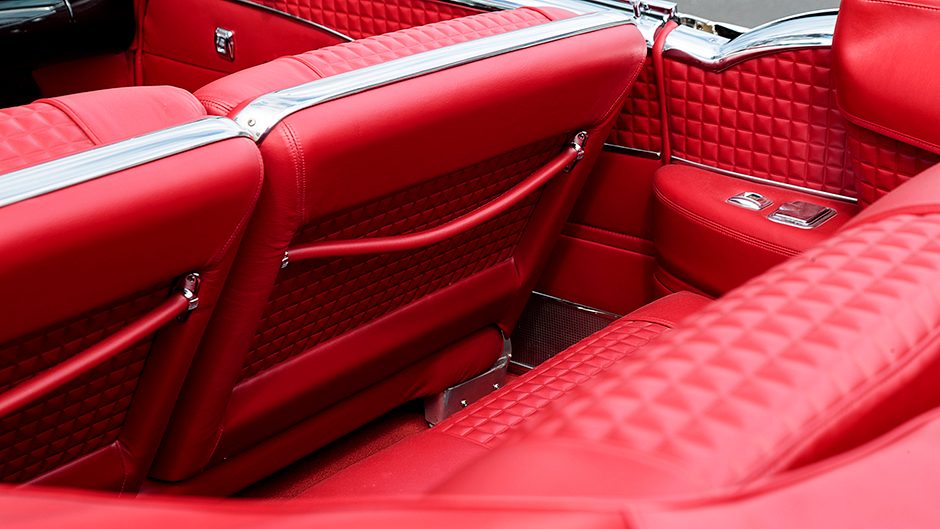
Still, when the covers came off the first Skylark at the Detroit Auto Show in January 1953, they say there were plenty of ‘oohs’ and ‘ahhs’ heard from an appreciative audience. The Skylark convertible shared the stage with two sibling softtops from GM – the Oldsmobile Fiesta and the Cadillac Eldorado. However the murmurs of approval died out as soon as pricing was announced.
At $US5000, the Skylark cost 50 per cent more than the Roadmaster ragtop on which it was based, and it lacked the trick wrap-around windscreen of the slightly more expensive Olds and Caddy. That the 1953 Skylark would go on to outsell its Oldsmobile and Cadillac cousins confirms the appeal of its cut-down doors, lowered fenders, and custom-inspired, hacked-out wheel wells, all of which a West Coast customiser would instantly recognise.
Still, with just 1690 sales in its debut year, the Skylark could hardly be considered a success. It accounted for just 0.5 per cent of Buick’s total production volume in 1953, and GM’s management were probably glad they didn’t sell any more. Special measures were required to achieve the distinctive looks including a smoothing out of the body panels with molten lead. This meant that it took a lot of time for Buick to build a Skylark, leading to speculation that GM lost money on every one.
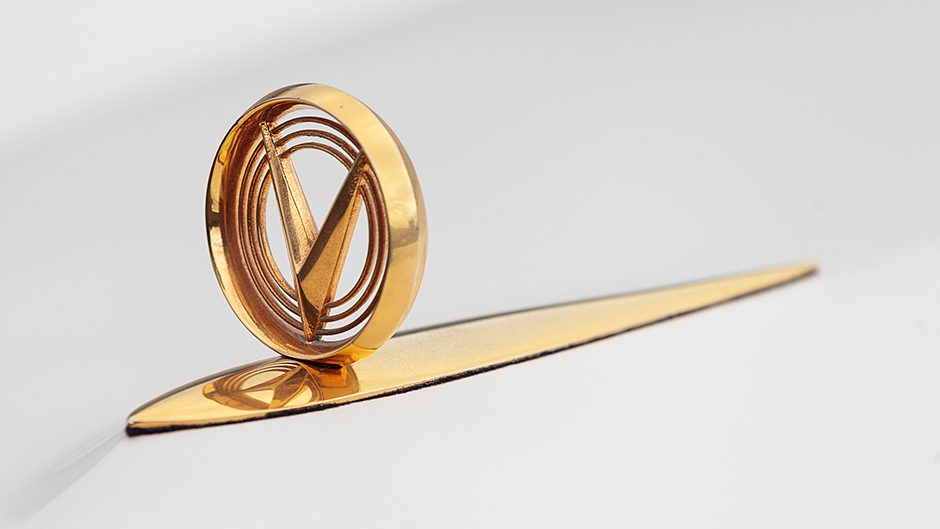
Still, it could have been worse. Oldsmobile sold just 458 Fiestas in 1953, and axed their new convertible after a single year. However, Cadillac could see a long game for the Eldorado and knew that it had the brand cachet to sustain the high prices. As for the Skylark, Stiles was convinced that his team had created a trend-setter (as proved by the success of the Thunderbird and Sport Fury a couple of years later), and was prepared to roll the dice again with the production of a much-revised version for 1954. Hence, a whole new deal for the car in the following year, one aimed at lifting its performance while cutting production costs.
Shifting the chromium-encrusted convertible to the lighter Century platform lowered both the mass of the car and the time needed to create it, and the Nailhead made more power in ’54, with a 149kW maximum output. A lot less hand labour went into the new version, enabling Buick to slash the price to $US4,483.
The ’54 Skylark certainly looked the part, with huge chromed tail fins sitting atop the rear fenders, a two-tone leather-trimmed interior, and new scalloped wheel wells. All ’54 Buicks had inherited the wheel well cutouts of the first Skylark, but the new scallops were a distinctive feature of the latest ‘lark, especially when painted blood red on some of the lighter coloured cars.
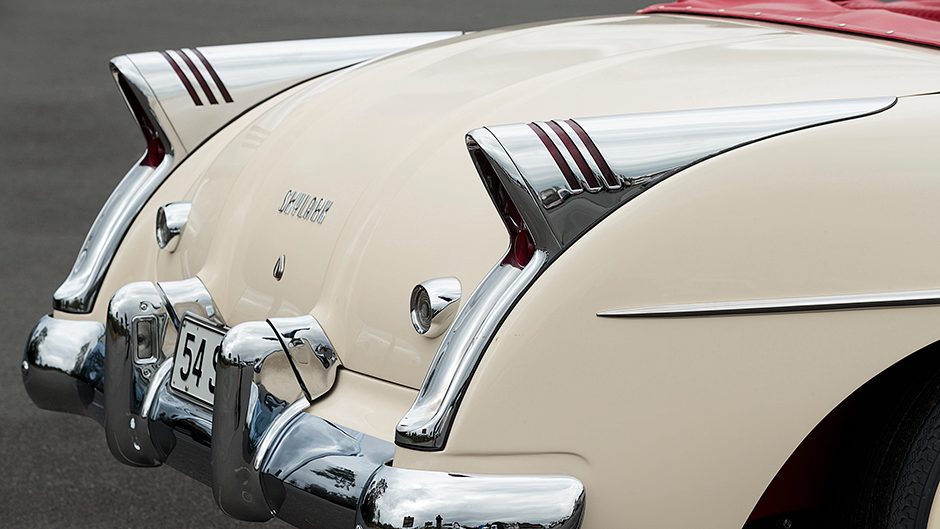
Those revisions would prove to be a wasted effort however when just 836 Skylarks were sold in 1954. Stiles had hoped that sales would lift to a point where he could add a hardtop version in 1955 to create a Skylark range capable of a sustained level of production. Instead, there was no point in continuing the production of these bejeweled rare birds.
Two months after Buick brought an early halt to Skylark production in November 1954, Ford would occupy the ‘American Sportscar’ gap that the car left in the market by unveiling its first Thunderbird.
The short production runs make the 1950s versions of the Buick Skylark keenly sought-after cars for collectors. Classic car experts reckon that there are only 75 left now of the improved 1954 version, and auction prices generally involve six-figure sums, now starting with a ‘2’. The ’54 in the Classics Museum in Hamilton was the only Buick Skylark in New Zealand ‘until a couple of years ago’ according to the museum’s founder, Tom Andrews.
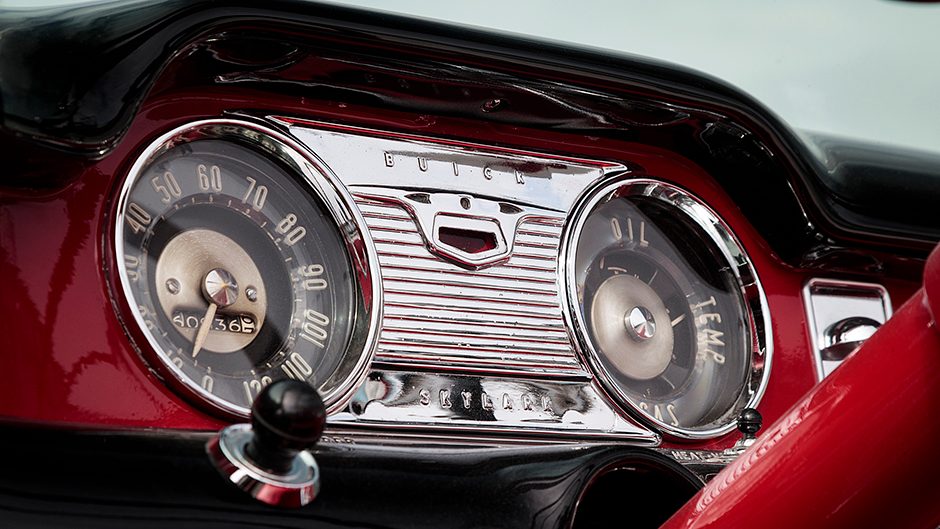
He found the car, in ‘pretty rugged condition’ at a salvage yard in Indianapolis, stripped off all the precious chromium trim for safe-keeping, and shipped it back to New Zealand. The strip down revealed some amateur details in GM’s build of the car. “These cars were as rough as guts from brand new. For example, when we removed the door cards we found that the holes for the window switches had been roughly cut with a gas torch into the doors.”
For museum technician, Wayne Johnstone, getting the ’54 Skylark up to display vehicle condition was a baptism of fire. “I first started working for Tom eight years ago, and when he brought the Skylark into the workshop, I saw it was a real mess. “He said ‘you’re going to put this back together for me’ but I’d never seen one of these before. “We had a donor car as well, and both cars were stripped right back, so the whole thing started with a massive pile of parts from the two cars, a manual, and a photo of what a Skylark was supposed to look like.
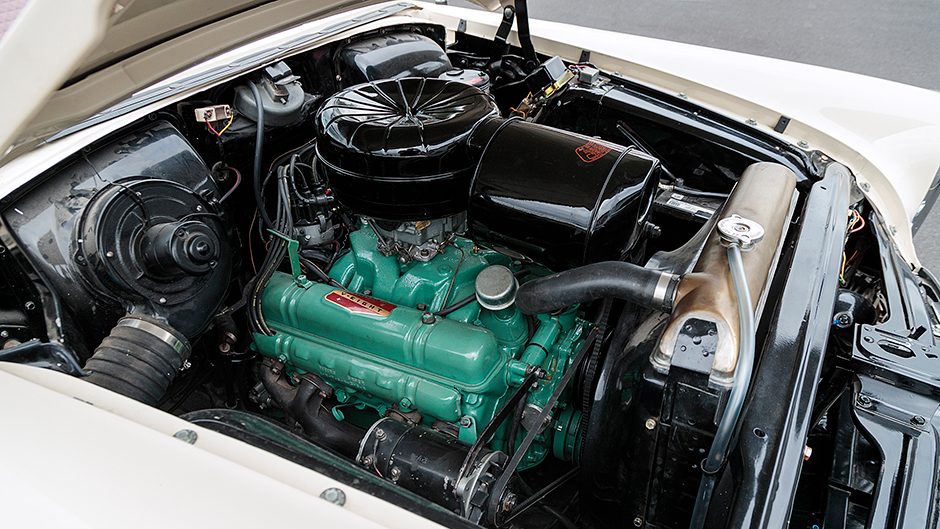
“It was one of those in-between jobs – something you work on when you’ve run out of other things to do – so that stretched out the rebuild to over five years.
“The dashboard seemed to have a million pieces to it, and refurbishing the stainless panels around the windscreen was a major job. Often things had to be done in the right sequence, so you’d have to pull the whole thing apart and start all over again.”
The way Wayne winces at these memories suggests he has a love/hate relationship with the finished car. But thanks to his and the rest of the team’s efforts, museum visitors get to see one of the rarest 1950s American cars in the world, one that bought the spice of West Coast culture to Detroit for the first time, and helped usher in a golden age of fantastic and fanciful design.


